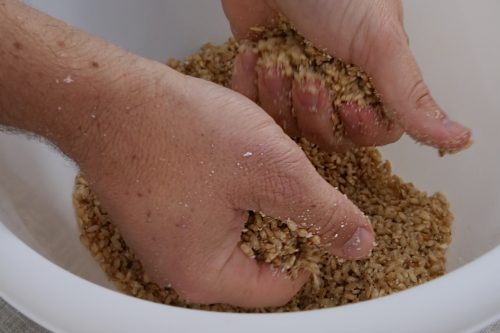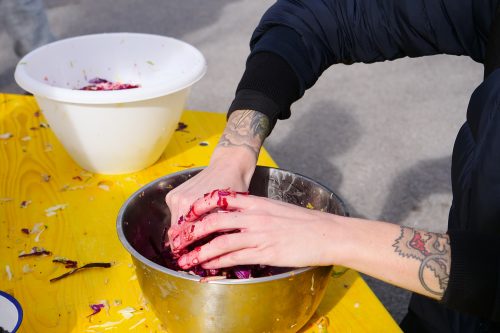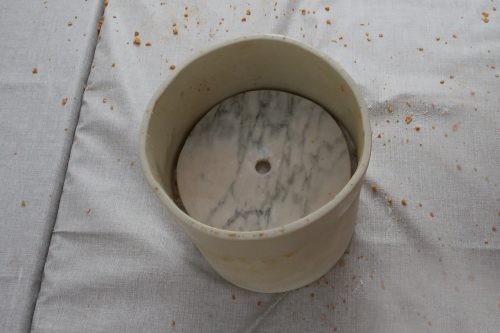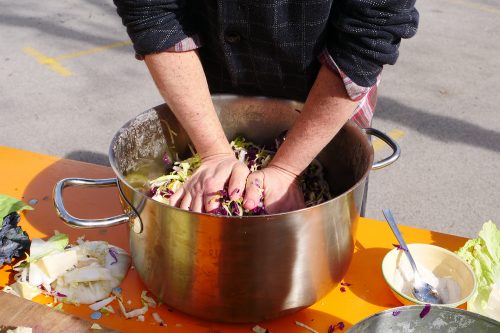There is a moment in the life of fruits and vegetables that has always puzzled and fascinated me. Put out a dish of strawberries, and in days some darker spots will appear. Maybe a thin tendril of mold sprouts out from the strawberry’s body. At this point, you can still eat it, simply by cutting off the moldy bit. But all of a sudden, the strawberry has clearly died. It’s inedible, sour. It has passed over in to the world of bacteria, mold, and minerals—it is no longer a self-regulating organism. It has stopped being an individual, but has become multitudes.
How does this happen? When is an organism living, and when is it dead? Where does death come from, and why does this change of state happen so quickly? Amazingly, we’ve developed some techniques to play with this boundary between life and death, stretch it, and blur it. I’m not talking about cryogenic freezing, blood transfusion, lab-grown meat, or any other modern technology. I’m talking about fermentation, the process of controlled decay of living organisms.
From coffee to ketchup, bread to sausage, wine to cheese, fermented foods are all around us. These types of fermentation tend to happen in far-off factories. Coffee berries are fermented before they’re roasted. To make ketchup, tomatoes are puréed en masse, left to rot, then heated to kill the bacteria. We usually don’t get the chance to see for ourselves the transformation of life—into other forms of life.
But you can. In this essay, I talk about fermentation: what makes it so magical, why people are so afraid of it. I talk about some strategies people use to make fermentation part of their daily life, and why modern life makes it so hard to do so. And finally, I speak to the ethics of fermentation—what we can learn from it and how it can help us think differently.
Taking time
Consider nukadoko, a fermented rice bran from Japan. Stir together salt, water, and bran—with optional ginger, dried fruit, and spices. Then ‘plant’ some vegetables like radish, beets, or carrots, burying them deep in the ‘soil’. Stir up to three times a day, preferably with your hands: get those skin microorganisms in there. After a week, you’ll have an active fermentation. Pretty soon it’ll be so strong that you can plant any vegetable in it and it’ll be pickled within one hour—these are then called nukazuke.
What happened? The salt inhibited the growth of the ‘bad’ bacteria and fungi. Without it, mold would’ve been sprouting all over the place, and the vegetables would’ve become inedible. Stirring it regularly ensures that the rice bran that was exposed to air gets buried again, so that any mold quickly dies in the anaerobic environment. Yeast starts eating the sugars in the vegetables, and then our friend Lactobacillus turns it into vinegar.
Make nuka, and you get to watch the transition from living organism to a crowd of multitudes. The only catch: to care for your nuka properly, you need to stir it daily, sometimes twice a day. The privilege of tending to life and death takes time.
To care for your nuka properly, you need to stir it daily, sometimes twice a day
Rosemary Liss, an artist who works with fermentation in her practice, learned about nuka at Hex Ferments, a group of food alchemists in Maryland, USA. ‘We had a pot and it was like a pet we had to tend to daily. I loved this ritual—the gestures and movements—it felt like a dance. Each day we lifted the heavy crock off the shelf, removed its colorful fabric covering and then unearthed the pickles before aerating the bran and adding fresh veg to the bed for a short lactic sleep.’
In Japan, the nuka gets passed down from generation to generation; each develops its own special flavors. They become unique microbiomes, only able to survive because of the daily work of grandmothers, mothers, and daughters. We have them to thank for this strange gift.
But that daily magic can quickly disappear when you get too precise. When Liss had the chance to start a residency at the Nordic Food Lab, she decided to work on nuka. She spent months trying to perfect it for a Nordic context. As she noted, ‘When this process was removed from the vibrancy of Hex and into a laboratory with only food grade plastic vessels available for controlled research I felt the magic had been lost.’
There’s something about fermentation that transcends exact science: it wants to be integrated into the rhythm of life. This rhythm is erratic; it’s embedded in culture, tradition, and habits.
Low-tech solutions for modern problems
When I talk to people new to fermentation, they often ask if it’s different from canning. According to Alex Lewin, author of Real Food Fermentation and Kombucha, Kefir, and Beyond, fermenting is the opposite: ‘It’s unlike canning—with canning you kill all of the microbes and seal it hermetically. With fermentation you invite the microbes you want and don’t let in the ones you don’t. Fermentation is diplomacy and canning is a massacre. Canning is a high-tech food technology.’
Canning requires glass and the ability to shape metal in very precise ways. That makes canning uniquely modern. Part of the conceit of modernity is that, to solve our problems, we need more high-tech solutions. But many of our problems are caused by technology in the first place—consider nuclear weapons, air pollution, climate change, and industrial food waste. On the other hand, fermentation is low-tech. You don’t need to be an expert to preserve food, or any fancy technology. Just a bucket, some salt, and trust in the world of bacteria and fungi.
One of the charms of fermentation is that it can help us deal with food waste. Our modern food system is extremely wasteful, with 30-40% of food going into the landfill in the United States, with 21% occurring at a household level. What’s more, it’s incredibly energy-intensive: 33% of global warming-related emissions come from agriculture. If consumers were to learn how to ferment at home, they could preserve their food without having to cook or freeze it—both requiring more energy. That makes it a low-tech solution to a high-tech problem.
Fear of having to care
If fermentation is so easy, why isn’t everyone doing it? To write this article, I reached out to friends and friends-of-friends who regularly ferment, asking them why they do it and why they think many don’t.
Ariadna Rodriguez and Iñaki Alvarez run nyam nyam, an art collective based in Barcelona, Spain. Like many people I interviewed, they’ve been greatly inspired by Sandor Katz, writer of books like Wild Fermentation and The Art of Fermentation. So when I asked them why they think some people have negative reactions to it, they cited him: ‘People do project their fears and anxieties of bacteria on fermentation. The ironic thing is it has always been a strategy for food safety.’
They also think it has to do with something else: people’s fear of messing up. As they put it: ‘They’re scared of having to take care of other microorganisms, they say they will have to travel, they will forget. I think it’s about responsibility, a big word nowadays, because the food industry makes everything for you that just needs to go from fridge to pan.’
We grew up hearing the horror stories about botulism and canning going wrong and don’t realize the fermentation process is much different.
Lina and Adam Esbold, a couple from Sweden, shared similar perspectives. ‘Most people’, they said, ‘are skeptical, they don’t like the taste and are put off by the idea of healthy bacteria… Even more people simply don’t care.’ Rosemary Liss, the artist, also thinks it has something to do with people’s fears of food safety. ‘I think the fear of contamination and making one’s self sick is the biggest barrier. We grew up hearing the horror stories about botulism and canning going wrong and don’t realize the fermentation process is much different.’
For Mark Reynolds, who runs Naughty Nettle Medicinals, ‘Lack of experience or first hand knowledge is a key part of this. There are those who try it once and have something go moldy so they won’t try it again.’ And yet, people can also get pretty excited when they first learn about fermentation—and how little responsibility it actually requires. Lewin describes the moment when he learned about fermentation from Sandor Katz’s book. ‘My head exploded—you can do that with food? You can chop up cabbage and leave it on the counter for a month? How is that possible? Part of what appealed to me is how rebellious that is, to cut something up and not put it in the refrigerator.’
Making death part of life
I’ve often met people who tried to ferment something once, and then they either forgot about it or got scared they did something wrong. There are cupboards full of abandoned kombuchas, fridges littered with old kefir and unfed sourdough.
It’s easy to start fermenting, but it can quickly get dispiriting, and then embarrassing. Rodriguez and Alvarez note that many people might worry that they don’t have the time to ‘collaborate’ with these microorganisms. But, they say, ‘the good thing is that you can always start again, you can always put new tea in the kombucha and everything will be OK. So as we say in Spanish: “no hay mal que por bien no venga”‘ (there is nothing bad that can’t be turned into good).
Lina Esbold and Adam Karlsson say it all takes balance and going with the flow. ‘Some weeks the fermentation gets to take more time and energy, but the opposite is also true, and we just let the cultivations whither.’ And that’s OK, too. Lewin learned to keep his projects out in the open: ‘One thing I do is I leave all of my fermentation projects in plain sight. I see them every time I go in the kitchen. It’s like gardening, you go out and you look at it and poke at it every once in a while.’
There’s also a couple of tricks you can practice to keep your fermentations alive. If white mold appears, simply scrape it off and shake it around a bit. Lewin notes that even if it does go bad, ‘it will be very obvious and very visible: fluffy green spores and you throw it away. If you’ve never had kombucha or kimchi, if you don’t know what it tastes like and you don’t know if it’s bad or not, you either take the leap or you find someone who has tried it before.’
At some point, you might get tired of it all. Simply pause your fermentation by putting it in the fridge, or better yet, in the freezer. Fermentation starters can also survive several years when you dry them. Once you’re ready to start them up again, just add whatever it needs (sugar and tea for kombucha, milk for kefir, or flour for sourdough). And yet, even if you try your best, fermentation isn’t always easy to keep doing. Our jobs and school uproot us; we work 9-5 and come home exhausted. For those who work irregular hours, it’s hard to build up the routine and habits needed to maintain that sourdough or make yoghurt or kefir daily.
And then there’s the food system. The supermarket is anathema to fermentation: live fermentation generates carbon dioxide and methane, stinking up the aisles and bursting through the packaging. In other words, it’s messy and weird. Partly because our access to food is limited to what the supermarket has to offer, it’s not easy to get hold of kefir grains or a kombucha mother. And when we do, it’s hard to get guidance. It can be intimidating if you don’t know anyone with experience fermenting.
Our society is also marked by what food researchers call ‘de-skilling’. We’ve largely lost the food practices handed down to us over generations. What remains is a semblance of our past food cultures: fermented pickles become canned; sauces rich in character and variety become, simply, ketchup.
The supermarket is anathema to fermentation: live fermentation generates carbon dioxide and methane, stinking up the aisles and bursting through the packaging.
Part of this is the industrialized food system, but another part is also the way the economy shapes our lives. A few generations ago, most Westerners lived in multi-generational households, children together with grandparents, several families sharing tenements, and a vibrant street culture that came from dense living arrangements and reliance on walking as the primary means of transportation. With modernity, every tradition, every routine, every relationship is constantly shifting and torn apart.
And even though science has given us unprecedented ways to understand the food that we eat, it also has its limitations. It seems like every week a study comes out that overturns the guidelines on what we’re supposed to eat. We’ve grown up with the idea of an official expiration date—leaving our trust in food safety to some largely invisible process, determined by experts. We have the science to understand the invisible stuff going on in our kitchens and in our guts, but a cultural attitude of fear that stops us from playing with our food—an attitude that inhibits microbiomes from flourishing in our kitchens.
When I talked to Jyotsana Singh, a friend, about this, she pointed out that we lack a common sense of how food spoils and what’s safe or unsafe to eat. As she put it, ‘people don’t trust their senses’. Ironic, with so much information available ‘at our fingertips’. She grew up in a family where, when concerned if the milk was OK, they wouldn’t look at the expiry date but instead sniff it. Perhaps due to this common sense she grew up with, combined with a knowledge of basic chemistry and biology, she rarely has a feeling of risk or fear when making food.
Through our conversation, we decided that there’s an important distinction between habits—the kind that allow us to ferment on a daily basis; common sense—an intuition of what’s going on under the surface, informed by today’s science and cultural knowledge; and tradition, where our upbringing guides us with confidence in the food we eat and make. Maybe it’s a balance of these that helps foster fermentation practices.
If you think about it this way, there’s something very political about fermentation. Our job makes it difficult to form daily habits. The modern food system has atrophied our cultural knowledge and traditions of food preservation practices. It makes sense that so many people find it hard to integrate into everyday life. To create a world where fermentation is the norm, we’d need to change the world.
Thinking with fermentation
The living body is always on the point of passing over into the chemical process: oxygen, hydrogen, salt, are always about to appear, but are always again sublated; and only at death or in disease is the chemical process able to prevail. The living creature is always exposed to danger, always bears within itself an other…
-G. W. Hegel, Philosophy of nature
Thus politics… originated in the daily ferment of ordinary life in the agora.
-Murray Bookchin, Urbanization without cities: The rise and decline of citizenship
As Hegel realized two centuries ago, we carry others within ourselves. What makes the body keep its integrity, surrounded by constant danger? The practice of fermentation raises these kinds of questions, and helps us think through a different ethics of being.
For Rodriguez and Alvarez, getting into fermentation opened them up to seeing multiple connections in life. ‘It all feels as part of the same thing,’ they say when I ask them how fermentation is part of their daily life: ‘Eating it. Having something fermented every meal. Then taking care of all the microorganisms that coexist with us, maybe taking out the tea from the kombucha, or changing the water and adding the sugar to the water kefir, tasting how the chilis are doing fermenting in the sun, opening the miso every now and then, and so on and on.’
All of this, they say, helps them visualize ‘all this activity in different scales interconnected between all the agents, our bodies, the microorganisms.’ Fermentation also informed Lewin’s approach to life. ‘Fermenting establishes a dynamic equilibrium of microbes—getting people comfortable with that is hard. In our overly determined world where everyone wants to understand everything completely, a lot of people are uncomfortable making a leap of faith. It’s a good practice to help people let go a bit. Maybe we don’t have to measure everything exactly, maybe we don’t have to control everything completely.’
Maybe we don’t have to measure everything exactly, maybe we don’t have to control everything completely.
To practice fermentation, we need to multiply experiences, not just with bacteria and fungi, but also with each other. It takes human relationships to learn how to ferment, and it takes knowledge given to us through science and culture. It also takes common sense. This common sense emerges through interaction with others. In ancient Athens, strangers met at the agora, the market place. It was here that politics happened, where people could learn to discuss with each other. The agora was messy, it was ordinary, but it was also the foundation of Athens’ democratic system. What kinds of fermented goods, I wonder, were sold in the Athenian agora, and what kinds of political conversations did they provoke?
When modernity meets its end-point and creates a world where everything is sterile, controlled, and known, there will be little space for fermentation. But there will also be little space for free thought: thinking that bubbles up out of the corners, appreciates complexity, multiplies relationships, navigates the subtle contours of life and death.
Modern life makes fermentation unintuitive and difficult. But it’s precisely this practice that can help us come to a different way of thinking and approaching the world. A world where fermentation is integrated into our daily life might be a bit messier, but it would also be more caring to the many life forms with whom we co-exist. Perhaps it would be a world that lends itself to contemplation, letting us ponder the transition of life to death, rather than fearing it, hiding it away.
This article was written by Aaron Vansintjan as part of a collaboration between Low-tech Magazine and nyam nyam, an art collective based in Barcelona (Spain). The article forms part of the project “It is the microorganisms that will have the last word“, selected as an off-site project for Barcelona Producció 2017. The pictures were made by nyam nyam.
Aaron Vansintjan wrote several articles for No Tech Magazine & Low-tech Magazine. He keeps his own blog at Uneaven Earth.









